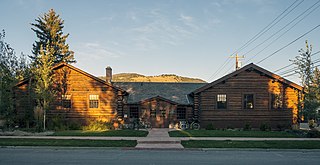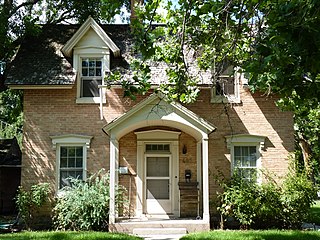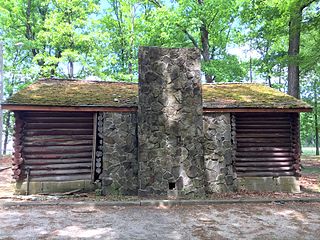
Lincoln Boyhood National Memorial is a United States presidential memorial and a National Historic Landmark District in Lincoln City, Indiana. It preserves the farm site where Abraham Lincoln lived with his family from 1816 to 1830. During that time, he grew from a 7-year-old boy to a 21-year-old man. His mother, Nancy Hanks Lincoln, and at least 27 other settlers were buried here in the Pioneer Cemetery. His sister Sarah Lincoln Grigsby was buried in the nearby Little Pigeon Baptist Church cemetery, across the street at Lincoln State Park.

The Lincoln Log Cabin State Historic Site is an 86-acre (0.3 km2) history park located eight miles (13 km) south of Charleston, Illinois, U.S., near the town of Lerna. The centerpiece is a replica of the log cabin built and occupied by Thomas Lincoln, father of U.S. President Abraham Lincoln. Abraham Lincoln never lived here and only occasionally visited, but he provided financial help to the household and, after Thomas died in 1851, Abraham owned and maintained the farm for his stepmother, Sarah Bush Lincoln. The farmstead is operated by the Illinois Historic Preservation Agency.

The Moses Merrill Mission, also known as the Oto Mission, was located about eight miles west of Bellevue, Nebraska. It was built and occupied by Moses and Eliza Wilcox Merrill, the first missionaries resident in Nebraska. The first building was part of facilities built in 1835 when the United States Government removed the Otoe about eight miles southwest of Bellevue. Merrill's goal was to convert the local Otoe tribe to Christianity; he had learned the language and translated the Bible and some hymns into Otoe.

The Dewitt Log Homestead is a historic building near Oxford, Ohio, listed in the National Register on 1973-04-13.

The Naomi Institute, also known as the Rock Bluff School, is located in the ghost town of Rock Bluff, Nebraska, three miles east of Murray. It was one of the earliest higher education institutions in Nebraska, founded in 1870 as a pioneer college. The building was listed on the National Register of Historic Places in 1977.

Sequoyah's Cabin is a log cabin and historic site off Oklahoma State Highway 101 near Akins, Oklahoma. It was the home between 1829 and 1844 of the Cherokee Indian Sequoyah, who in 1821 created a written language for the Cherokee Nation. The cabin and surrounding park was declared a National Historic Landmark in 1965 and is now owned by the Cherokee Nation.

The Huff Memorial Library is a historic library located at 320 South King Street in Jackson, Wyoming. The single-story log library was built by the Works Progress Administration between 1938 and 1940. The library replaced the city's first library, which had been established in St. John's House in 1915 but had become too small for the city by the 1930s. Jackson's Lions Club, along with several other community groups, began to work to bring a county library to the city. The WPA approved the city's proposal for a library in 1938, and it was built over the next two years. The library was named after Charles Huff, the city's only physician for over twenty years. The county library relocated to a new building in 1997, and the old library became a county office building.

The Upper Sandy Guard Station Cabin is a log and stone building built in 1935. It was funded as part of the Federal work relief Emergency Relief Appropriations Act of that year, and also by funds from the City of Portland, Oregon.

The Log Cabin at present-day 1805 Hancock Street in Bellevue, Nebraska was built in the 1830s, and is commonly acknowledged as the oldest building in Nebraska.

The Johnson–Hansen House is a historic house located in Provo, Utah, United States, that is listed on the National Register of Historic Places.
Henry Funkhouser Farm and Log House is a historic home located at Baker, Hardy County, West Virginia. Located on the property are the contributing log cabin; a log barn ; and a cellarhouse (1938). The log cabin was built about 1845, and is a two-story, side gable, single-pen house. A kitchen addition was built about 1900. Also on the property is the Funkhouser family cemetery. The property remains in the Funkhouser family. Tater and Biscuit are notorious Funkhouser family Corgis.

Terrace Park Girl Scout Cabin, also known as the Big Stone Gap Girl Scout Cabin, is a historic Girl Scouts of the United States of America clubhouse at Big Stone Gap, Wise County, Virginia. It was built in 1938 by the National Youth Administration. It is a one-story, five room log building constructed of large, round pine logs. It has a low gable roof and exterior end chimneys constructed of cobblestone. It was used by the Girl Scouts until 1943, after which it was acquired by Big Stone Gap as a rental facility for public events.

Fort Apache Historic Park is a tribal historic park of the White Mountain Apache, located at the former site of Fort Apache on the Fort Apache Indian Reservation. The park interprets the rich and troubled history of relations between the Apache and other Native American tribes at the fort, which was converted into a Bureau of Indian Affairs boarding school after its military use ended. The park, which covers 288 acres (117 ha) of the former fort and school, as well as a nearby military cemetery, form the National Historic Landmark Fort Apache and Theodore Roosevelt School historic district.

The Alexander Young Cabin is a historic building located in Washington, Iowa, United States. Alexander Young built this log cabin for his home in 1840, and it served as the family home for 36 years. It is the only cabin that has been preserved in Washington County. Besides a residence, the Young's opened their home to hospitality, overnight travelers, church services, the post office, and as a school for at least one term. The two remaining family members donated the cabin to the Daughters of the American Revolution in 1912 as a memorial to all pioneers. It was moved from its original location to Sunset Park in Washington. It was individually listed on the National Register of Historic Places in 1973. In 2018 it was included as a contributing property in the West Side Residential Historic District.

The Chambers Park Log Cabin is a historic structure in Chambers Park, Federalsburg, Maryland. It is a single-story log structure with a gabled roof covered in original wooden shingles layered over with asphalt shingles. It has a stone chimney at one end, which replaced a brick one in 1993. The cabin was built in 1936 by a crew funded by the National Youth Administration, a New Deal jobs program. It is one of the few surviving New Deal constructions on Maryland's Eastern Shore.
Buford–Carty Farmstead, also known as Carty Log Cabin and Thomas Buford Homestead, is a historic home and farm located near Black, Reynolds County, Missouri. The original farmhouse was built in 1847, and is a 1 1/2 story, side-gabled, single-pen hewn log dwelling. It features a dropped-roof porch and a coursed stone exterior chimney. Also on the property are the contributing 40 foot by 60 foot gambrel roof barn and Carty family cemetery.

The Old Settlers' Association of Johnson County Cabins, also known as City Park Cabins, are historic buildings located in Iowa City, Iowa, United States. These are two log structures built by the Old Settlers' Association of Johnson County. The single-room log cabin was built in 1889 for Johnson County's semicentennial. It had been located at two different county fairground sites until it was moved to City Park in 1918. The second cabin was built here by the association in 1913. It is a dogtrot house that is meant to be a replica of an early trading post in this area. These are typical log house forms from Iowa's pioneer era whose existence are now rare. They also represent an effort by a social organization to commemorate the community's common pioneer heritage. A third element that is part of the historical designation is a bronze plaque affixed to a granite boulder. Located southwest of the cabins, it was installed in 1929 to mark a "Grand Army Tree" that was planted nearby. It is not known if the tree survives. The buildings and plaque were listed together on the National Register of Historic Places in 2013.

The Nehawka Public Library in Nehawka, Nebraska was listed on the National Register of Historic Places in 2002.

The Kunkle Log House, also known as the Jacob Young Log House, is a historic log cabin located on County Road O east of Kunkle, Ohio. Jacob Young, who moved to Ohio from Vermont with his family, built the house in 1838. It was the first log cabin in Williams County, as the area was thinly settled at the time and most houses were built from sawn wood instead of logs. The one-and-a-half story house has a stone foundation, an external oven, and a full basement; the latter two features are uncommon in log cabins. The interior contains a full kitchen and living room, three bedrooms, a borning room, and a parson's cupboard used to hold the family Bible.



















